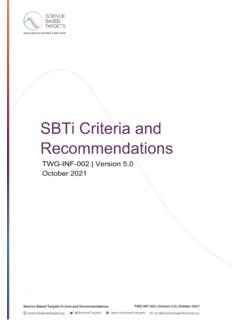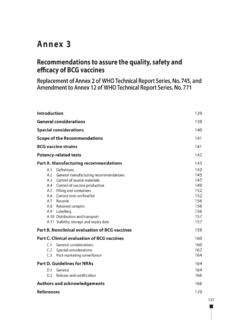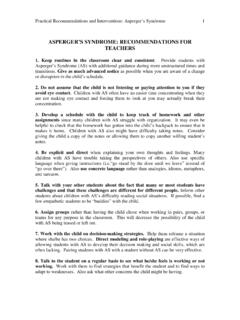Transcription of WHO Guidelines for the Production, Control and …
1 Post ECBS version ENGLISH ONLY. EXPERT COMMITTEE ON BIOLOGICAL STANDARDIZATION. Geneva, 17 to 21 October 2016. WHO Guidelines for the production , Control and Regulation of Snake Antivenom Immunoglobulins World Health Organization 2016. All rights reserved. Publications of the World Health Organization can be obtained from WHO Press, World Health Organization, 20. Avenue Appia, 1211 Geneva 27, Switzerland (tel.: +41 22 791 3264; fax: +41 22 791 4857; e-mail: Requests for permission to reproduce or translate WHO publications whether for sale or for non-commercial distribution should be addressed to WHO Press, at the above address (fax: +41 22 791 4806; e-mail: The designations employed and the presentation of the material in this publication do not imply the expression of any opinion whatsoever on the part of the World Health Organization concerning the legal status of any country, territory, city or area or of its authorities, or concerning the delimitation of its frontiers or boundaries.))
2 Dotted lines on maps represent approximate border lines for which there may not yet be full agreement. The mention of specific companies or of certain manufacturers' products does not imply that they are endorsed or recommended by the World Health Organization in preference to others of a similar nature that are not mentioned. All reasonable precautions have been taken by the World Health Organization to verify the information contained in this publication. However, the published material is being distributed without warranty of any kind, either expressed or implied. The responsibility for the interpretation and use of the material lies with the reader. In no event shall the World Health Organization be liable for damages arising from its use.
3 The named authors [or editors as appropriate] alone are responsible for the views expressed in this publication. Adopted by the Sixty-seventh Meeting of the World Health Organization Expert Committee on Biological Standardization, 17- 21 October 2016. A definitive version of this document, which will differ from this version in editorial but not scientific details, will be published in the WHO Technical Report Series. This is a pre-publication ECBS-approved document but may yet be subject to minor editing to meet WHO style guide and other requirements. Post ECBS version Page 2. CONTENTS. 1 Scope and application of the Guidelines ..7. 2 List of abbreviations and definitions ..8. 3 The ethical use of animals.
4 13. Ethical considerations for the use of venomous snakes in the production of snake venoms ..13. Ethical considerations for the use of large animals in the production of hyperimmune Ethical considerations for the use of animals in preclinical testing of antivenoms ..14. Development of alternative assays to replace murine lethality testing ..14. Refinement of the preclinical assay protocols to reduce pain, harm and distress to experimental animals ..14. Main 4 General considerations ..16. Historical background ..16. The use of serum versus plasma as source Antivenom purification methods and product safety ..16. Pharmacokinetics and pharmacodynamics of Need for national and regional reference venom preparations.
5 17. 5 Epidemiological Background ..18. Global burden of snakebites ..18. Main 6 Worldwide distribution of venomous Taxonomy of venomous snakes ..20. Medically important venomous snakes ..23. Minor venomous snake species ..25. Sea snake venoms ..26. Main 7 Antivenoms design: selection of snake venoms ..29. Selection and preparation of representative venom mixtures ..29. Manufacture of monospecific or polyspecific antivenoms ..29. Monospecific antivenoms ..29. Polyspecific antivenoms ..29. Main 8 Preparation and storage of snake production of snake venoms for immunization ..31. Quarantine of Maintenance of captive snakes for venom production ..32. General maintenance of a serpentarium ..33. Snake venom production .
6 34. Staff responsible for handling snakes ..35. Safety and health Personal Protective Equipment (PPE) for snake or venom handling ..36. Procedures to be followed if a bite occurs ..36. Main 9 Quality Control of venoms ..38. Records and National reference materials ..38. Characterization of venom batches ..38. Main 10 Overview of the production process of antivenoms ..40. 11 Selection and veterinary health care of animals used for production of antivenoms ..42. Post ECBS version Page 3. Selection and Quarantine period ..42. Veterinary care, monitoring and vaccinations ..42. Animal health and welfare after inclusion in the herd ..42. Main 12 Immunization regimens and use of adjuvant ..45. Animals used in antivenom production .
7 45. Venoms used for immunization ..45. Preparation of venom doses ..45. Detoxification of venom ..46. Immunological adjuvants ..46. Preparation of immunogen in adjuvants ..47. Immunization of animals ..47. Traceability of the immunization process ..49. Main 13 Collection and Control of animal plasma for fractionation ..51. Health Control of the animal prior to and during bleeding Premises for blood or plasma collection ..51. Blood or plasma collection session ..51. Labelling and identification ..52. Collection and storage of whole blood ..52. Plasma collection by automatic apheresis and storage ..53. Pooling ..54. Control of plasma prior to fractionation ..54. Main 14 Purification of immunoglobulins and immunoglobulin fragments in the production of antivenoms.
8 56. Good manufacturing practices ..56. Purification of the active substance ..56. Purification of intact IgG antivenoms ..56. Purification of F(ab')2 antivenoms ..57. Purification of Fab antivenoms ..58. Optional additional or alternative steps used by some manufacturers ..63. Analysis of bulk product before Dispensing and labelling of final product ..64. Use of preservatives ..64. Freeze-drying ..65. Inspection of final container ..65. Archive samples of antivenoms ..65. Pharmacokinetic and pharmacodynamic properties of IgG, F(ab')2 and Fab ..65. Main 15 Control of infectious risks ..68. Background ..68. Risk of viral contamination of the starting plasma ..68. Viral validation of manufacturing processes.
9 68. Down-scale experiments ..71. Selection of viruses for the validation of antivenom production processes ..71. Viral validation studies of antivenom immunoglobulins ..72. Caprylic acid Acid pH treatment ..74. Filtration steps ..74. Validation of dedicated viral reduction Other viral inactivation treatments currently not used in antivenom manufacture ..75. Possible contribution of phenol and cresols ..75. Post ECBS version Page 4. production -scale implementation of process steps contributing to viral safety ..75. Transmissible spongiform Main 16 Quality Control of Standard quality assays ..78. Appearance ..78. Solubility (freeze-dried preparations) ..78. Extractable Venom-neutralizing efficacy Osmolality.
10 78. Identity test ..78. Protein Purity and integrity of the immunoglobulin ..79. Molecular-size distribution ..79. Test for pyrogen substances ..79. Abnormal toxicity test ..80. Sterility Concentration of sodium chloride and other excipients ..80. Determination of pH ..80. Concentration of preservatives ..80. Chemical agents used in plasma fractionation ..80. Residual moisture (freeze-dried preparations) ..80. Antivenom reference preparations ..81. Main 17 Stability, storage and distribution of antivenoms ..82. Stability ..82. Storage ..82. Distribution ..82. Main 18 Preclinical assessment of antivenom efficacy ..84. Preliminary steps which may limit the need for animal Essential preclinical assays to measure antivenom neutralisation of venom-induced lethality.
















